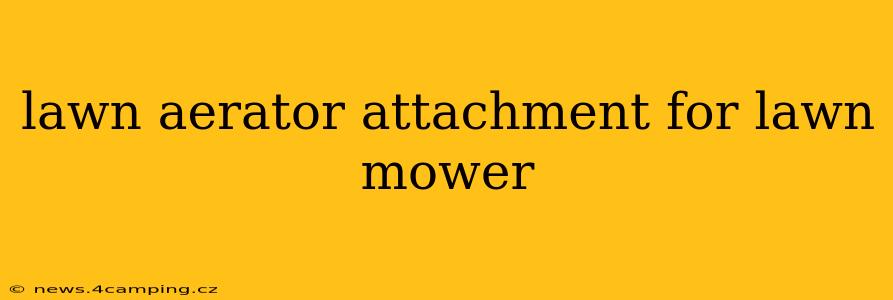Maintaining a healthy, vibrant lawn requires more than just regular mowing. Compacted soil can suffocate grass roots, leading to thinning turf, brown patches, and increased susceptibility to disease. That's where lawn aerators come in, and specifically, lawn aerator attachments for your lawn mower. These handy tools offer a convenient and efficient way to improve soil aeration, resulting in a lusher, greener lawn. This comprehensive guide will explore everything you need to know about choosing and using a lawn aerator attachment.
What is a Lawn Aerator Attachment?
A lawn aerator attachment is a device that fits onto your existing lawn mower, transforming it into an aeration machine. These attachments typically consist of a series of tines, cores, or spikes that puncture the soil, creating small holes that allow air, water, and nutrients to reach the grass roots more easily. They are a cost-effective alternative to purchasing a standalone aerator, especially for those with smaller lawns.
Different Types of Lawn Aerator Attachments
Several types of lawn aerator attachments cater to various needs and lawn types. Understanding the differences will help you select the best option for your lawn:
1. Spike Aerators:
- Mechanism: These attachments use sharp metal spikes to pierce the soil. They're best for relatively soft soil and offer a quick, less labor-intensive aeration process.
- Pros: Affordable, easy to use.
- Cons: May not be as effective on heavily compacted soil; can potentially damage grass blades if used improperly or aggressively.
2. Core Aerators:
- Mechanism: Core aerators remove small plugs of soil, creating larger holes than spike aerators. This is generally considered more effective for long-term soil improvement.
- Pros: Creates larger holes, offering superior aeration and thatch removal. Ideal for compacted soil.
- Cons: More expensive than spike aerators; may require more effort, particularly on larger lawns. Can create a messy lawn with discarded soil plugs.
How to Choose the Right Lawn Aerator Attachment
Selecting the appropriate lawn aerator attachment depends on several factors:
- Lawn Size: For smaller lawns, a spike aerator attached to a push mower might suffice. Larger lawns benefit from a core aerator, potentially attached to a riding mower for efficiency.
- Soil Type: Heavily compacted soil requires a core aerator to effectively break up the soil. Softer soil might tolerate a spike aerator.
- Budget: Spike aerators are generally cheaper than core aerators.
- Mower Compatibility: Ensure the attachment is compatible with your lawn mower's model and type (e.g., push mower, riding mower).
How Often Should I Aerate My Lawn?
The frequency of aeration depends on several factors, including soil type, grass type, and traffic on the lawn. However, a good rule of thumb is to aerate your lawn once or twice a year, ideally in the spring or fall. Heavily compacted soils or high-traffic areas may benefit from more frequent aeration.
What are the Benefits of Using a Lawn Aerator Attachment?
- Improved Drainage: Aeration allows water to penetrate the soil more easily, preventing waterlogging and promoting healthy root growth.
- Better Nutrient Absorption: Aeration allows fertilizers and other nutrients to reach the roots more effectively.
- Reduced Thatch Buildup: Thatch, a layer of dead grass and organic matter, can suffocate grass roots. Core aerators, in particular, help remove thatch.
- Healthier, Thicker Lawn: By improving soil conditions, aeration leads to a healthier, more vibrant, and thicker lawn.
- Increased Resistance to Disease: A well-aerated lawn is less susceptible to diseases and pests.
Can I use a lawn aerator attachment on all types of lawn mowers?
No, not all lawn aerator attachments are compatible with all lawn mowers. Always check the manufacturer's specifications to ensure compatibility with your specific lawn mower model. Some attachments are designed for specific types of mowers (e.g., push mowers, riding mowers).
How do I maintain my lawn aerator attachment?
After each use, clean the attachment thoroughly to remove any soil or debris. Regularly inspect the tines or cores for damage or wear and replace them as needed to maintain effectiveness. Proper maintenance extends the life of your attachment.
Conclusion
Using a lawn aerator attachment is a simple yet highly effective way to improve the health and vitality of your lawn. By choosing the right type of attachment and following proper usage and maintenance practices, you can create a lush, green lawn that thrives for years to come. Remember to consider your lawn's specific needs and your budget when making your selection.
